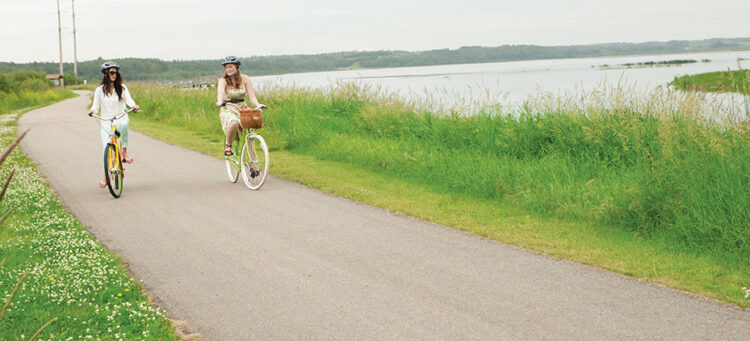
In the Spotlight
Big Lake
By: Carmen D. Hrynchuk & Gene Kosowan PHOTOGRAPHY: BRENDA LAKEMAN
May, 2024
A look at one of Alberta’s most important aquatic sanctuaries.
When your backyard is 1,800 hectares of trails, wetlands and history, escaping the city is a walk in the park. For residents of St. Albert and other communities in the capital region, that escape is Lois Hole Centennial Provincial Park. Established in 2005, the park—named in honour of our 15th Lieutenant Governor—preserves Big Lake, a freshwater wetland ecosystem. Never been? There’s no time like the present. Getting there is as easy as accessing the boardwalk off Riel Drive or following the Red Willow Trail west along the south bank. A viewing platform, boardwalk and interpretive centre all await your arrival.
Connected to the park along Big Lake’s eastern shoreline is the John E. Poole Wetland, an interpretive site dedicated to conserving Canada’s wetlands. Doubling as an education destination, the area provides a critical habitat for thousands of migrating and nesting shorebirds and waterfowl. But our amazing wetlands don’t just provide for wildlife. They work hard for us too, storing twice the carbon found in the tropical forests of the world, while occupying only six percent of the earth’s land surface.
Big Lake, which takes its name from the Cree’s moniker “Mistihay Sakigan,” makes up 59 percent of the park’s total area and is eight km. long and three km. wide at its widest point. Globally recognized as one of the 20 most important habitat areas in Alberta, it’s also home to an estimated 235 bird species, including trumpeter swans, peregrine falcons, short-eared owls and bald eagles. In the lake’s waters are schools of fish that include goldeye, northern pike, stickleback, walleye, white sucker and walleye, while the rest of the provincial park area is occupied by mammals that include beaver, coyote, mink, moose, muskrat, porcupine, red fox, red squirrel, skunk, snowshoe hare, and white-tailed deer.
It sits on the sand and gravel of the Empress Formation, an aquifer 30 metres below its surface that was laid down by meltwater from the massive Laurentide and Cordilleran glaciers that dominated the surface of North America before retreating as far back as 15,000 years ago. Vegetation subsequently spiked around 6,000 years later, in the form of trees and grasslands during the Hypsithermal period, when the climate heated to temperatures that were warmer than today’s average readings
by up to three degrees Celsius.
That period seems to coincide with evidence that humans first began to occupy the area, according to archaeological discoveries of ancient tools dating as far back as 5,000 years, although many scholars believe nomadic tribes had passed through the area at least 4,000 years earlier.
After Father Albert Lacombe established his mission in the area in 1861, its residents often ventured to Big Lake, to fish, hunt moose and deer, and trap beaver and muskrat. By 1914, Big Lake’s reputation as a tourist attraction escalated thanks to the paddlewheel boat the Ste. Thèrésa, which took passengers to the lake from St. Albert, which by now had become a village.
But it wasn’t until much more recently that the provincial government recognized the ecological significance of the lake, declaring it to be among Alberta’s 20 most important natural habitats. In 1999, it dedicated 1,119 hectares of the lake and surrounding land to becoming the Big Lake Natural Area, and recognized it as an important bird sanctuary two years later. By 2024, 19 years after the area became a provincial park, the government expanded its size by another 238 hectares, declaring that it be used only for nature-based activities.
Like all great visits that end, a goodbye at Big Lake gives pause for gratitude. To stand on the shore at sunset is a reminder of that. And it’s with that feeling that conservation begins. It may seem like a small thing, but feeling that you are part of something bigger—something you want to experience again and share with others—is an important part of the conservation equation. In recognizing the hard work of others, you not only help bring change, you help sustain it.t8n
(This story was updated from the June, 2015 edition of T8N)













